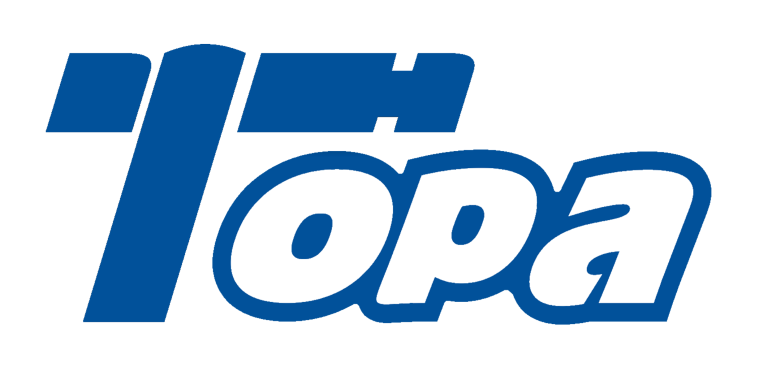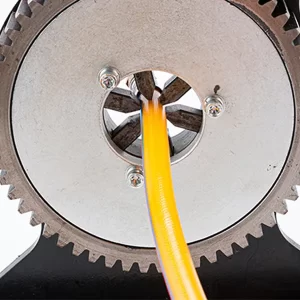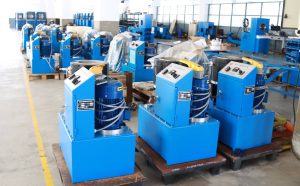Importing hydraulic hose crimpers from China is a crucial decision for businesses looking to enhance their hydraulic systems’ performance. It’s not just about saving costs, but ensuring high-quality machinery that fits your production needs. This article will guide you through the entire process of importing hydraulic hose crimpers from China, helping you make informed decisions every step of the way.
1. What is a Hydraulic Hose Crimper?
A hydraulic hose crimper is a machine used to attach hydraulic fittings to hoses. This process is essential in hydraulic systems, which rely on high-pressure hoses to transmit fluids. Without crimpers, hoses would not connect properly to fittings, potentially causing leaks or failures.
But here’s the kicker—not all hydraulic hose crimpers are created equal. They come in various types, each serving different needs. Manual crimpers are suitable for smaller, low-volume operations, while automatic and industrial crimpers are designed for larger-scale businesses. These machines offer precision, ensuring that hoses fit perfectly with their fittings.
What’s the real story? The crimping process involves compressing the hose and fitting to create a tight seal. This seal ensures that the hose will withstand the pressures of fluid flow, especially in industrial or agricultural applications where the hoses need to handle intense conditions.
2. Why Should You Consider Importing Hydraulic Hose Crimpers from China?
Importing hydraulic hose crimpers from China offers numerous advantages. Ready for the good part? The main attraction is cost savings. China has a well-established manufacturing industry that can produce high-quality crimpers at competitive prices. These savings can be passed on to your customers or reinvested into your business for growth.
What’s the catch? While the price is a key advantage, the quality of Chinese-made hydraulic hose crimpers has improved significantly over the years. Many Chinese manufacturers now adhere to international standards and have certifications that guarantee the quality of their products. For instance, you might come across suppliers with ISO 9001 certifications, indicating a robust quality management system.
Table 1: Advantages of Importing Hydraulic Hose Crimpers from China
| Factor | Benefit |
|---|---|
| Cost savings | Lower production and shipping costs |
| High-quality standards | ISO-certified suppliers and international compliance |
| Manufacturing capacity | Ability to meet large order volumes |
| Technological innovation | Advanced designs and efficient machines |
3. How to Choose a Reliable Hydraulic Hose Crimper Supplier in China?
When importing hydraulic hose crimpers from China, selecting a reliable supplier is key to success. Here’s where it gets interesting—many businesses fail to consider the importance of supplier research. A reputable supplier will offer transparent communication, good after-sales service, and reliable product warranties.
But here’s the kicker—you don’t have to blindly trust suppliers based on their claims. You can request samples of their products and conduct independent quality checks. Some companies even allow you to visit their factories in China, giving you the opportunity to verify the production processes firsthand.
Table 2: Key Considerations When Choosing a Supplier
| Factor | Description |
|---|---|
| Supplier reputation | Check reviews and past customer feedback |
| Quality control processes | Inquire about testing and inspection methods |
| After-sales service | Understand warranty and support options |
| Factory visit | Arrange visits to confirm factory operations |
4. What Are the Common Challenges When Importing Hydraulic Hose Crimpers from China?
While importing hydraulic hose crimpers from China can be highly beneficial, there are several challenges you need to be aware of. What’s the real story? Logistics can often be a headache. Shipping international freight involves customs clearance, which can delay delivery times. Additionally, import duties and taxes can add unexpected costs, which may eat into your profit margins if not accounted for.
Here’s the kicker—while shipping delays are common, there are ways to streamline the process. You can work with freight forwarders who specialize in handling imports from China. These experts can manage customs paperwork and find the most cost-effective shipping methods.
Table 3: Common Import Challenges
| Challenge | Solution |
|---|---|
| Shipping delays | Use experienced freight forwarders |
| Customs clearance | Ensure all paperwork is accurate and complete |
| Unexpected costs | Account for import duties and taxes in the budget |
5. What Are the Different Types of Hydraulic Hose Crimpers Available for Import?
There are different types of hydraulic hose crimpers available in the market. This is where it gets interesting—knowing which one to import depends on your business needs. Manual crimpers are ideal for smaller businesses that don’t need high-volume production. They’re affordable, easy to use, and require little maintenance.
On the other hand, automatic crimpers are designed for high-volume applications. These machines can crimp large numbers of hoses quickly, making them ideal for factories or large-scale operations. Industrial-grade crimpers are built for heavy-duty use and are capable of handling the most demanding environments, such as construction or mining operations.
Table 4: Types of Hydraulic Hose Crimpers
| Type | Best for |
|---|---|
| Manual crimpers | Small businesses or low-volume use |
| Automatic crimpers | High-volume production environments |
| Industrial-grade crimpers | Heavy-duty use in demanding industries |
6. How Do Import Duties and Taxes Affect the Cost of Hydraulic Hose Crimpers?
Import duties and taxes play a crucial role in determining the total cost of importing hydraulic hose crimpers. But here’s the kicker—underestimating these costs can throw off your budget, potentially turning a cost-effective deal into a financial burden. The first step is to understand the tariff rates imposed on hydraulic equipment. These vary depending on the country of import and the specific product category.
What’s the real story? While it may seem like these duties add a lot of overhead, working with a customs broker can help navigate the complexities of international trade. They can offer advice on how to minimize costs and stay compliant with local regulations.
Table 5: Example Import Duty Rates for Hydraulic Equipment
| Country | Duty Rate (%) |
|---|---|
| United States | 5-10% |
| European Union | 4-7% |
| Canada | 8-12% |
7. How to Negotiate Prices with Chinese Suppliers for Hydraulic Hose Crimpers?
Negotiating prices with Chinese suppliers requires patience and strategy. What’s the real story? One of the most effective techniques is to ask for multiple quotes from different suppliers. This allows you to compare pricing and negotiate for a better deal. Suppliers often provide discounts for bulk orders, so ensure you are clear on your order volume to take advantage of these offers.
Ready for the good part? If a supplier is unwilling to negotiate, it may be a sign that they are not flexible enough for long-term business relationships. Don’t be afraid to walk away and explore other options if the terms aren’t favorable.
8. What Documentation Do You Need When Importing Hydraulic Hose Crimpers from China?
Proper documentation is vital for clearing customs when importing hydraulic hose crimpers. But here’s the kicker—many importers underestimate the complexity of paperwork, which can cause delays and even result in penalties. The basic documents you need include the commercial invoice, packing list, certificate of origin, and Bill of Lading.
What’s the real story? Understanding the documentation process ahead of time can save you from unnecessary headaches. It’s also wise to verify that the supplier provides all necessary paperwork in the correct format.
9. How to Ensure Quality Control When Importing Hydraulic Hose Crimpers?
Quality control is essential when importing hydraulic hose crimpers. What’s the real story? Ensuring that you receive top-quality equipment can save your business from costly repairs or replacements down the line. Before placing an order, request a sample or visit the factory to inspect the production process. Third-party inspections are another option for ensuring that the crimpers meet your standards.
But here’s the kicker—once the crimpers arrive, you can perform your own quality checks, looking for defects or inconsistencies that could indicate poor manufacturing.
10. What Shipping Methods Are Available for Importing Hydraulic Hose Crimpers from China?
When importing hydraulic hose crimpers from China, choosing the right shipping method is crucial. What’s the catch? There are two main options: air freight and sea freight. Air freight is faster but more expensive, making it ideal for smaller orders or when time is of the essence. Sea freight is more affordable, especially for large shipments, but it takes longer to reach the destination.
Ready for the good part? A reliable freight forwarder can help you choose the most cost-effective method based on your budget and delivery timeline.
11. How to Handle Payments When Importing Hydraulic Hose Crimpers from China?
Handling payments for imports can be tricky. What’s the real story? When paying for hydraulic hose crimpers, it’s crucial to use a secure payment method. Bank transfers are common, but for added security, you can use a letter of credit (LC), which provides protection for both parties. Some suppliers may also offer payment terms, allowing you to pay in installments once the equipment is shipped.
Here’s the kicker—always double-check the terms and conditions, especially when working with a new supplier. Payment fraud is a risk, so taking the necessary precautions is essential.
12. What Are the Safety Standards for Hydraulic Hose Crimpers?
Hydraulic hose crimpers must meet specific safety standards to prevent accidents during operation. Ready for the good part? Safety standards vary by country, so make sure that the crimpers you import comply with local regulations. Common standards include CE certification in Europe and UL certification in the United States.
But here’s the kicker—failing to comply with these standards could lead to fines or, worse, equipment malfunctions that endanger workers. Always verify that your crimpers meet the required safety certifications.
13. How Do You Set Up a Hydraulic Hose Crimper After Importation?
Setting up a hydraulic hose crimper properly is essential to ensure its longevity and optimal performance. This is where it gets interesting—while setup can vary depending on the model, most crimpers require calibration, proper fitting of hoses, and adjustments for different hose sizes. Be sure to follow the manufacturer’s instructions and perform initial tests before full-scale use.
Ready for the good part? Some suppliers offer setup services, where they send technicians to assist with installation. If this service is available, it can save time and ensure that the crimper is set up correctly from the start.
14. What After-Sales Support and Warranty Options Are Available for Imported Hydraulic Hose Crimpers?
After-sales support is crucial when importing hydraulic hose crimpers. But here’s the kicker—always check the warranty and return policies before completing a purchase. A good supplier will offer a warranty for the crimper, covering parts and labor for a specified period.
What’s the real story? Effective after-sales support can mean the difference between a smooth operation and costly downtime. Look for suppliers who provide responsive customer service and technical assistance in case of issues.
15. How to Find More Suppliers for Hydraulic Hose Crimpers in China?
If you’re looking to expand your options, there are numerous ways to find additional suppliers for hydraulic hose crimpers in China. What’s the catch? You can attend trade shows, use B2B marketplaces, or rely on recommendations from industry colleagues. This will allow you to compare prices, product quality, and after-sales services.
Ready for the good part? Expanding your supplier network can lead to better deals and diversified risk, giving you more flexibility in sourcing hydraulic hose crimpers.
FAQ Section
Q1: What is a hydraulic hose crimper?
A hydraulic hose crimper is a machine used to attach hydraulic fittings to hoses, ensuring a leak-proof connection for high-pressure applications.
Q2: How does importing hydraulic hose crimpers from China work?
You find a reliable supplier, negotiate prices, handle paperwork, and arrange shipping. It’s important to understand tariffs, taxes, and customs procedures.
Q3: What factors should I consider when choosing a hydraulic hose crimper supplier?
Look for reputable suppliers, check reviews, verify quality control procedures, and ensure good after-sales support.
Q4: How can I ensure the quality of hydraulic hose crimpers imported from China?
Request samples, conduct factory visits, and use third-party quality inspections to ensure the crimpers meet your standards.
Q5: Are there any risks when importing hydraulic hose crimpers from China?
Challenges can include shipping delays, customs clearance, unexpected costs, and communication barriers. Work with experienced importers to minimize risks.




